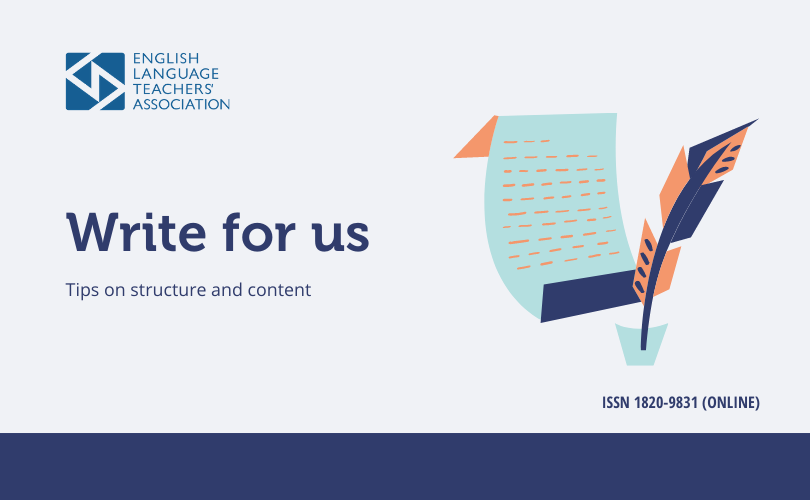Before plunging into writing, here are some tips on structure and content of your article for you to consider:
STRUCTURE
- Coherence
Make sure your sentences and paragraphs are logically connected, either by naming the order of ideas dealt with (e.g. There are two reasons…first…second…), using cause and effect connectors (e.g. Since the idea is to…, it goes to show that…), chronological connectors (e.g. giving a historical overview, or describing the start, the details and the end of a process) or comparison and contrast connectors (e.g. comparing trends, listing features of groups, categorizing etc.).
Don’t forget to clearly state the central idea of your article: the purpose or the goal. You can state this in the introductory chapter and later develop throughout the other sections.
e.g.
The goal of this article is…
My idea is to share with you the experience of working with young learners…
The central idea is to show how…
Don’t be too optimistic with the promises you cannot deliver later on in the text.
- Clear layout
Draw an outline of your article before writing it, with headings and subheadings under the main parts (introduction, main body, and conclusion) – that should keep the building blocks of it in place, and the structure easy to follow.
- Paragraphing
Each paragraph should have a central idea in a topic sentence that then develops. A topic sentence is one that tells the reader what the paragraphs is about. The sentences around it are supporting sentences that develop the idea in more detail, providing evidence or examples. You might want a concluding sentence that sums up the idea in different words and comments on the idea’s purpose in relation to your whole article. This helps the reader understand the text’s overall message.
New paragraphs give the reader a chance to rest and take in what was written, and also give you a chance to move on to the connecting idea or change the pace of the article.
- Language
Before submitting the article, check it for spelling, grammar or other mistakes. We suggest putting the article away for a day and then rereading it with fresh eyes, on paper if possible. This technique will help you notice previously overlooked errors. Ideally, ask a colleague to proofread it.
As MELT/Newsletter are not academic journals, we allow semi-formal and teacher-friendly style of writing. If you are fond of using idiomatic expressions, phrasal verbs or humour in order to engage the reader better into your writing, go ahead!
- Gender
Avoid sex bias in your use of English and check your writing for the stereotypical misuse of the masculine noun ‘man/mankind’, pronoun ‘he’ or the possessive adjective ‘his’ when referring to a group. (e.g. NOT The teacher helps his students, but: Teachers help their students, NOT Most men say, but Most people/individuals say…etc.)
- Referencing, citations, font, alignment
If your work uses existing ideas, theories or someone’s direct quote, you need to cite the source properly and include it in your reference list. For the full guide on these, as well as on style, please refer to the submission guidelines on our website.
CONTENT
- What should I write about?
The best place to start is drawing from your own experience in the classroom. Perhaps there is a lesson you want to share with your colleagues, a useful tip or advice for them or something you picked up on a teacher development course and applied it successfully in your classroom. Maybe you are organizing a creative or stimulating activity at your school? Or you might want to write a more academic article on the topic of your interest.
Whatever you choose, make sure you have a clear idea of what your topic is and present it accordingly. Ask yourself: Does your article really deal with the topic you stated in its title?
Here are some reflective questions that may help you to get started:
- What are the areas of teaching I’ve developed in particular throughout my career?
- What would I like to share about this area with my colleagues?
- How did I solve a particularly challenging situation in my classroom?
- What did I learn and apply from the latest seminar I attended? etc.
- How do I engage with the reader?
In order to build a relationship with the reader, do not just write about the subject matter, but also, occasionally, write about how the text is evolving. (e.g. Now I suggest we look at…, And so to conclude…, The next stage would be… etc) It means writing about writing, and it implies you are aware of the reader’s need for elaboration and lightens the reader’s cognitive burden.
To write a reader-friendly article, provide familiar context before introducing new information.
Always check your work for ‘flawed logic’ – do your conclusions really follow from the premises? If your students seem especially demotivated and you are teaching grammar, does it follow that grammar is demotivating?
- What is my contribution?
Before submitting your articles ask yourself about the significance and novelty of your contribution. Is your article shedding some new light on an old topic? Will it help your colleagues advance their practices? Does it offer practical solutions to emerging classroom issues?
Above all, write about what you are interested in and have fun with it. We hope you find these tips useful and we are looking forward to your next (or first) contribution to our newsletter.
Your editorial team

